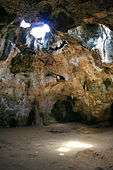Caves of Aruba
| Caves of Aruba | |
|---|---|
|
Two large domes shaped entrance to the Guadirikiri Cave | |
| Location | Aruba |
| Length |
Guadirikiri Cave 98 feet (30 m) Fontein Cave 50 metres (164 ft) Baranca Sunu Cave (LOve Cave) 300 feet (91 m) |
| Geology | Limestone |
Of the several caves of Aruba, three Aruban caves are well known, seen in deep crevices on the windward face of the island. All three of the caves are located in the Arikok National Park. The most prominent are Guadirikiri Cave, the Fontein Cave and the Huliba Cave. Nocturnal bats nestle in all these caves.[1][2]
The importance which the Government of Aruba attaches to these three caves is borne by the fact that postage stamps with images of them were issued by Post Aruba in April 2009 in specific denominations. The stamp of 175 cents value depicts the Baranca Sunu Cave, the stamp of 200 cents denomination depicts the Fontein Cave, and the stamp of 225 cents value shows the entrance of Quadirikiri Grot (Guadirikiri Cave).[2]
History
The history of the caves was initially linked to the Amerindians, a semi nomadic tribe who lived on the Aruba island about 4000 years ago. However, a small branch of Arawak Indians, known as Caquetio, inhabited this island around 1000 AD. The villages inhabited by them were near the towns of Santa Cruz and Savaneta, and the carvings inside the caves and rock faces testify to this inference.[3] Historians have also inferred that Arubans also lived in caves but mainly for the purposes of performing sacrificial services and holding assemblies, and sometimes also to hide in the caves during enemy attacks.[4][5]
Guadirikiri Cave
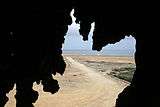
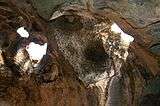
The Guadirikiri Cave (also known as "Quadiriki Caves") is notable for its two large dome-shaped chambers which are illuminated with sunlight through holes in the ceiling. Entry to the cave is at the base of the cliff. This 492-foot (150 m) long cave is also a nesting site for numerous small nocturnal bats, which are harmless. In order to preserve the natural habitat of the cave for the bats to breed, one of the caves is barred for visitors.[1][6]
A somewhat dubious folk tale relates to a daughter of an Indian chief who fell in love and was imprisoned in the cave as her paramour was not acceptable to her father. Her beloved one was imprisoned nearby, in Huliba Cave (Tunnel of Love), but both lovers managed to meet underground. Both reportedly died in the cave and their spirit vanished into heaven through the holes in the roof of the cave.[6][7]
Fontein Cave
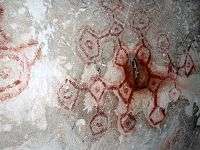

The Fontein Cave is a small cave near Boca Prins on the northern part of the island. It is well known for its native Arawak drawings on the wall, which were decoratively etched by Amerindians on the stones walls and flatter roof portion of the cave in brownish-red colour or reddish brown or purplish colour; this in turn gives a clue to the history of the Amerindians. The cave is accessible from an "escarpment of a terrace of coral limestone" and has a width of 3 metres (9.8 ft) and a height of 2 metres (6 ft 7 in). The entrance hall, which is open for visitors, is 4 metres (13 ft) in height and extends to a depth of 50 metres (160 ft). As it is in limestone geological formation, solution effect due to seeping water has resulted in colourful stalagmites and stalactites formations in very odd shapes and sizes. Long tongued bats nestle in the holes of the cave which go on their nocturnal hunt to collect and feed on food in the form of nectar and pollen.[1][2][6] It is also reported that Arawak Indians used to perform their tribal rituals and ceremonies inside this cave.[2]
Huliba Cave
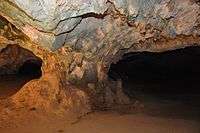

The Huliba Cave (known as the "Baranca Sunu cave" also meaning "Naked Rock") is nicknamed the "Tunnel of Love" for its heart-shaped entrance. The entrance is through a steep and narrow stairway which dips into the cave. It has five entrances. At places, one has to crouch to see the formations. Flashlights are needed to explore the 300 feet (91 m) long passageway, as it is totally dark inside the cave. The cave is studded with stalagmites and stalactites formations in limestone rocks. Two bat species residing in this cave include the Southern Long-nosed Bat and long-tongued Fruit Bat. It is interesting to watch when the bats, after sleeping in the caves during the day time, fly out in hordes in search of food. The exit from the tunnel is through a series of steps that are carved on the rock face and are quite risky. In one of the chambers, the Virgin Mary has been carved in the natural rock formation. Legend mentions about pirates inhabiting the cave to hide their treasures, though there is no proof to confirm this.[1][2][6][8][9]
Gallery
References
- 1 2 3 4 "Aruba – Nature and Scientific Wonders". Smithsonian Magazine. 6 November 2007. Retrieved 23 December 2010.
- 1 2 3 4 5 "New Stamp Issue: Caves of Aruba". Aruba Tourism Authority. 2010. Retrieved 23 December 2010.
- ↑ Lynne M. Sullivan (1 June 2006). Adventure Guide to Aruba, Bonaire & Curacao. Hunter Publishing, Inc. pp. 55–56. ISBN 978-1-58843-572-9. Retrieved 23 December 2010.
- ↑ Johannes Hartog (1980). Aruba: short history. Van Dorp. p. 8. Retrieved 23 December 2010.
Aruban Indians frequently lived in caves…
- ↑ "Indian Rock Art". Centralbank.an/museum. Archived from the original on 13 July 2014. Retrieved 29 December 2010.
the walls of "subterranean caves" on the north coast of Aruba. They are believed to have been places of refuge for the Indians….Historian Hartog (1961) suggests that the caves may have been shelters or sacrificial sites. Religious ceremonies are also mentioned. The fact that in many caves there were springs -so water- seems to be an indication that there used to be (male) inaugural ceremonies during which possible wounds could be cleansed.
- 1 2 3 4 "Arikok National Park". The New York Times. 20 November 2006. Retrieved 23 December 2010.
- ↑ "Quadirikiri Cave". Wondermondo.
- ↑ Sullivan, p.82
- ↑ Soriano, P. & Molinari, J. (2008). "Leptonycteris curasoae". IUCN Red List of Threatened Species. Version 2009.2. International Union for Conservation of Nature. Retrieved 7 February 2010.

